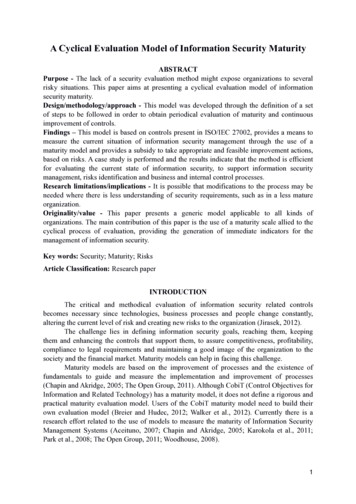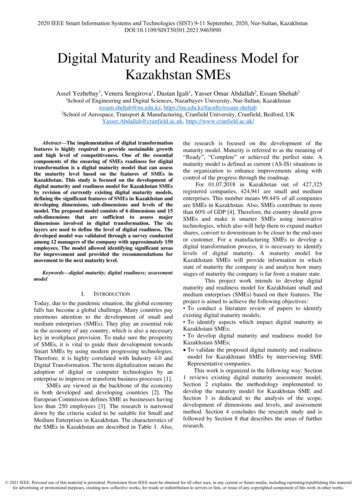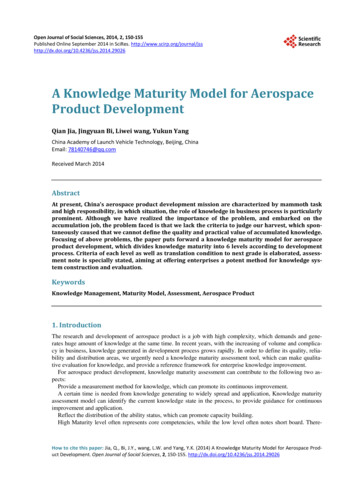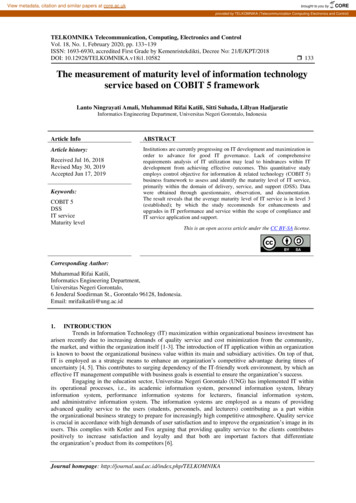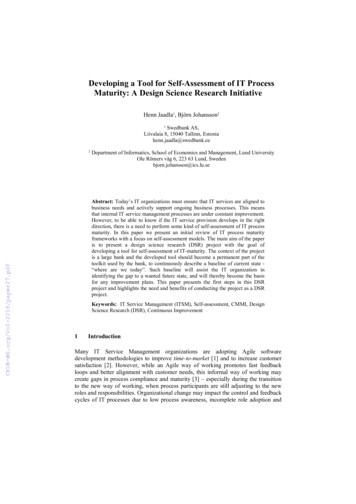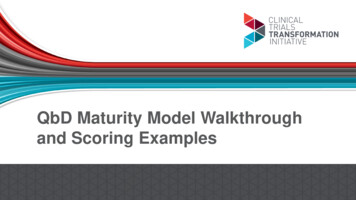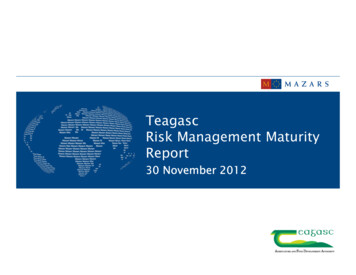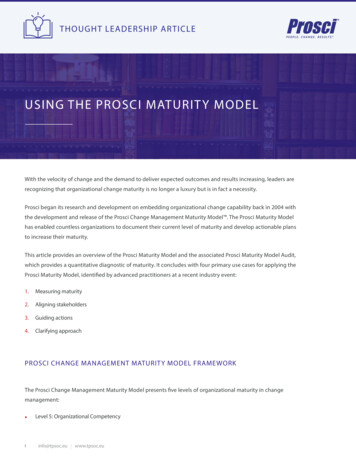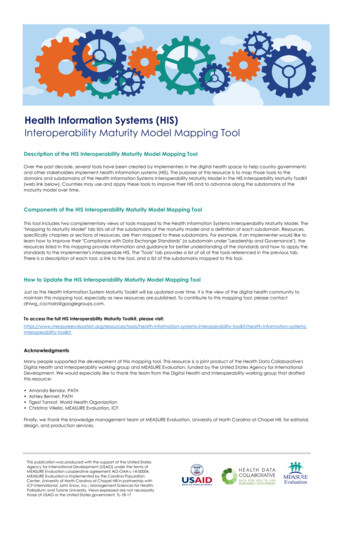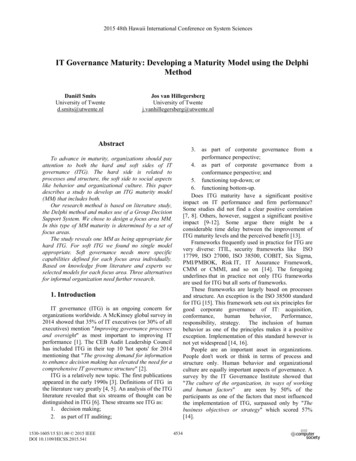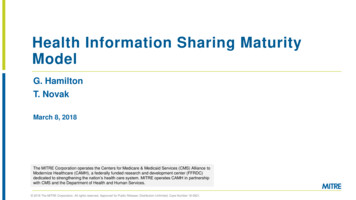
Transcription
Health Information Sharing MaturityModelG. HamiltonT. NovakMarch 8, 2018The MITRE Corporation operates the Centers for Medicare & Medicaid Services (CMS) Alliance toModernize Healthcare (CAMH), a federally funded research and development center (FFRDC)dedicated to strengthening the nation’s health care system. MITRE operates CAMH in partnershipwith CMS and the Department of Health and Human Services. 2018 The MITRE Corporation. All rights reserved. Approved for Public Release; Distribution Unlimited. Case Number 18-0621.
2 What is Health Information Sharing (HIS)The sharing of health and healthcareinformation (HIS)Electronically across key participantsand stakeholders toImprove health and healthcare practices Ensures health information is available at theright place at the right time for the right person Lowers burden on healthcare providers andpatients Improves efficiency of healthcare system andlowers costs Best of all, IMPROVES HEALTH OUTCOMES! 2018 The MITRE Corporation. All rights reserved. Approved for Public Release; Distribution Unlimited. Case Number 18-0621.
3 Enabling Health Information Sharing:The HIS Maturity Model (HISMM) A maturity model will enable Health Information Sharing by:– Providing states with a mechanism to assess the maturity of health information exchange within a state’shealthcare Enterprise.– Ensuring the most effective use of scarce resources, leveraging common efforts, both public and private– Ensuring that best practices and lessons learned, such as increased modularity, are incorporated– Improving reuse of solutions across states HIS Maturity Model benefits– Helps prioritize areas that may require technology supports/enhancements Reveals the mitigations and workarounds needed to support a program– Helps you understand gaps, where you may need to make more Health Information Technology (HIT)investments Demonstrates how to mature a capability based on cost/benefit analysis and resource– Helps with overall HIT planning Helps identify gaps and determine steps to incrementally improve the capability Provides the steps to use in building the roadmap to improve the capability 2018 The MITRE Corporation. All rights reserved. Approved for Public Release; Distribution Unlimited. Case Number 18-0621.
4 Why Do We Care About Maturity LevelsLow MaturityHIS capabilities that: share inaccurate information require manual entry have inefficient workflowsHigh MaturityHIS capabilities that: share accurate information enable automation have efficient workflowsResults in:Results in: medical errors provider burden need for additional staffing better care coordination forpatients less burden on providers reductions in admin staff andcontractorsOverall, a capability with a high maturity can achieve delivery system reform goals 2018 The MITRE Corporation. All rights reserved. Approved for Public Release; Distribution Unlimited. Case Number 18-0621.
5 Proposed HIS Capabilities to Include in Maturity ModelAdmission, Discharge and Transfer(ADT) Events/Encounter AlertingAdvanced DirectivesAnalytics ReportingCare PlansClaims Information Sharing/All-Payer Claims DatabasesDeath ReportingDisease and Public Health RegistryInformationElectronic PrescribingEligibility and Benefits InformationEMS IntegrationFinancial InformationHealth RecordImage SharingImmunization RegistryLab OrdersLab ResultsPatient ConsentPatient EducationPatient-Generated DataPatient IdentifierPatient Portal InformationPatient Record LocatorPopulation Health InformationPrescription MonitoringProvider AttributionProvider DirectoryQuality ReportingReferral ManagementRisk AssessmentSocial Determinants of HealthOnly select the ones that support your program goals 2018 The MITRE Corporation. All rights reserved. Approved for Public Release; Distribution Unlimited. Case Number 18-0621.
6 HIS Maturity Model Components Programs: The Why (Goal)– Provides understanding of what capabilities are neededto achieve a State Medicaid Agency goal Example: Behavioral Health Integration Capabilities: The What– The functionality you are exploring Example: Provider Directory Dimensions: The How– The tool/mechanism that supports a specificfunctionality Example: Measure the level of Usability 2018 The MITRE Corporation. All rights reserved. Approved for Public Release; Distribution Unlimited. Case Number 18-0621.
7 HIS Maturity Model Components: Program SheetsPurpose: To layout what is needed to attain program goals. Used to Identify– Main objectives– Outcomes– Stakeholders– Relevant capabilities How to use:– To review capabilities and identify priorities– Refer to relevant Capability sheet to help estimatematurity level and target level– To identify additional stakeholders and outcomes– As a communication tool to socialize needs withstakeholders 2018 The MITRE Corporation. All rights reserved. Approved for Public Release; Distribution Unlimited. Case Number 18-0621.Example: Behavioral HealthIntegration Program
8 HIS Maturity Model Components: Capability SheetsPurpose: Provides a capability definition and example of maturity levels tohelp communication/understanding Identify– Programs– Stakeholders– Low, medium, high, maturity level summary Provides a common mechanism forcommunication How to use:– Review capability description– Identify additional stakeholders– Review maturity level descriptions – toestimate as is and target maturity state 2018 The MITRE Corporation. All rights reserved. Approved for Public Release; Distribution Unlimited. Case Number 18-0621.Capability Example: ADT Events
9 HIS Maturity Model Dimensions: Criteria for AssessmentInformation QualityTechnicalDimensionsPeople &ProcessDimensionsTransportSecurityWhat is the maturity of the data transport mechanisms used? Push/PullWhat mechanisms are in place to ensure data is shared securely?Transaction/QueryWhat is the level of adoption of the Application Programming Interface(API) used?Usability/WorkflowHow easy is the information to consume? Is the information incorporatedinto the /PrivacyData GovernanceStakeholder GovernanceGovernanceDimensionsIs the data being shared, timely, usable, high quality, complete and relevant?SustainabilityHow many different mechanisms are available?Can all possible participant types (providers, patients, payers, .) for thecapability, participate, and how many are actually participating?Can patients control (provide consent) who has access to data about them toa granularity appropriate to the capability?How mature are the processes to govern data involved in exchanges?How mature is the organizational structure and associated processes togovern exchanges for this capability?What are the resources available to sustain efforts for any capability; people,funds, skills, leadership? 2018 The MITRE Corporation. All rights reserved. Approved for Public Release; Distribution Unlimited. Case Number 18-0621.
10 HIS Maturity Model Assessment StepsIdentifyProgramIdentify the State program goal that willdrive the needed Information Technology(IT) capabilitiesIdentifyUse the program sheets to determine and prioritize the required capabilitiesCapabilities &Stakeholders and identify all stakeholders that will be involved in the assessmentReviewCapabilitySheetsUse capability sheets to determine expectations for thecapability maturity levelUseDimensionsAssess current maturity for each capability againsteach dimension.TargetMaturityLevel andIdentify GapsDetermine target maturity for each capability against eachdimension. Use dimension sheet to identify gaps to achievedesired level.IdentifySteps toAddress 2018 The MITRE Corporation. All rights reserved. Approved for Public Release; Distribution Unlimited. Case Number 18-0621.Identify incremental steps to address the gaps.Use these identified steps to inform a roadmapto improve capability.
11 HIS Maturity Model on Centers for Medicare & MedicaidServices (CMS) zONE HISMM available for review on zONE Maturity Model– Executive Summary– Presentation– Spreadsheet model Information/Capability sheets– Behavioral Health– ADT Events– Health Record Information Discussion Forum– Leave comments, ask questions! Instructions available for access 2018 The MITRE Corporation. All rights reserved. Approved for Public Release; Distribution Unlimited. Case Number 18-0621.
12 For More InformationTo learn more or provide feedback on the HIS MaturityModel, please contact Tom Novak (Thomas.Novak@hhs.gov). 2018 The MITRE Corporation. All rights reserved. Approved for Public Release; Distribution Unlimited. Case Number 18-0621.
13 Follow upTo download a copy of this presentation, visit:https://health.mitre.org/himss18Data Interoperability toReduce Clinician BurdenFollow us on social media: @MITREhealth 2018 The MITRE Corporation. All rights reserved. Approved for Public Release; Distribution Unlimited. Case Number 18-0621.
14 Reference Slides
15 How a Maturity Model is Used to Improve a Capability A maturity model shows how a capability can be improved“step by step” Each level lays out critical success factors for the capability– Expectations are made clear As objectives to improve the capability to get to the next levelare clear this enables:– Incremental Improvement: Helps identify gaps and determinesteps to incrementally improve the capability– Roadmap Development: Provides the steps one can use tobuild the roadmap for improving the capability Identify realistic target– Can determine which level is achievable for the capabilitybased on cost/benefit analysis and resources 2018 The MITRE Corporation. All rights reserved. Approved for Public Release; Distribution Unlimited. Case Number 18-0621.
16 How a Maturity Model is Used to Improve a Capability(Continued)levelInformation QualitytechnicaltransportIs the information timely, of high quality, complete Is the mechanism used toand relevant ?exchange the datastandardized,documented, and proven?Ensure that the protocolsupports requiredcommunication betweenparticipants (e.g., requestand response). Averageacross exchanges for thecapability maturity level.Transport maturity levelsfor the capability maturitylevel.0 No exchanges occurring for information in thiscapability area1Information available in external systems.Some Information is non-human readableMainly unstructured, little structured meta data,across multiple systemsNo metrics defined for information quality.All protocols custom andprivate and notdocumentedSecurityTransaction/QueryWhat mechanisms are in place toensure data is shared securely?What is the level ofadoption of the APIs used?Baseline CIA policies have beendefined but implementation is adhoc and manualSeparation of duties mainly admindefinedSystems meet all required Federaland state security policiesCIA needs defined2 Measurable metrics defined for information quality documented non-standardSome automation to meet CIAMeasurable metrics defined for informationprotocolsbaseline policies. These processescompletenessare repeatable require no manualSome (not all) information from less than 50% ofinput.external systemsIdentification of all policies thatSearchable: Results mainly unstructured, ad-hoccould be automated.formats or PDF with key meta-data structuredCommitment to tracking policyHuman readableconformance is in place.Identification of process improvementOngoing efforts to further automate.Baseline requirements met, threatsidentified and plan to mitigatedefined3Alignment/DuplicationDimensionHow many differentmechanisms for thiscapability are in use byend users?people and processUsability/ WorkflowparticipationHow easy is the data toconsume? Is the dataincorporated into theworkflowMultiple efforts thatduplicate capability, withno effort to reconcileUndocumented API (toquery information)proprietaryMultiple efforts thatInformation available inless than 25% of theall or nothing consent to all exchanges of the sameduplicate capability,same system but notpotential participant types data access for specifictype of data haveIdentification of areas ofintegrated.(as defined by capability)providers but no other governance agreements inoverlapRequires extensive manual but all participants ofparticipant typesplace but not from aeffort to reconcile, orthose types exchangingcommon basisduplicate data entryAreas identified forautomation andimprovement .Information searchable within workflowAt least one documented Full automation to enforce need to Using proven standardsSome information are from less than 50% ofstandard protocol in use. know, separation of duties and least (XDS-b, API standardized)available external systemsAnd used consistentlyprivilege policies.for queryData mainly structuredacross the organization.Tracking is in place to trackHuman readable.Metrics collected on APIs.conformance with policies, andMeasurement of information quality againstidentify areas for furtherdefined metrics ad-hocautomation.Measurement of information completeness againstCIA requirements monitored.defined metrics ad-hocPlan to address threats to CIAUse cases for relevance determined. With someimplementedmetrics identified.Multiple efforts thatoverlap capability, withbusiness case specificvariations identifiedInformation available inless than 25% of theseparate systempotential participant typesInformation is available (as defined by capability)but not readily accessible. and not all participants ofthose types exchangingNumber ofdimensions:TA Intermediary andInterfaceTA Access & Delivery: Security &PrivacyTA Integration & Utility:UtilityTA Integration & Utility:Utilitygovernancestakeholder governancesustainabilityall or nothing generalconsent onlysome exchanges of theno governancesame type of data for the organizational structure incapability do not haveplacegovernance agreements inplaceTA Integration & Utility:Utilityat least 50% of theconsent to access specific data exchange governancepotential participant types classes of data in specifichas quantitative(as defined by capability)ways (e.g., viewing,measurement in place toexchanging with at leastannotating, adding,assess process75% of possibleupdating) for specificparticipants of those types providers but no otherexchangingparticipant typesat least 95% of potential consent to access specificparticipants of allclasses of data in specificpotential participant typesways (e.g., viewing,(as defined by capability)annotating, adding,are exchangingupdating) for specificparticipants of any typeBA Utility or Value toStakeholdersTA Access & Delivery:Security & Privacygovernance organizational Uncertainty in fundingstructure in place but doesover the next 5 yearsnot include representation Funding source is unstablefrom all stakeholdersInconsistent leadership(participant types thatsupport.participate in capability)and defined governanceprocesses existgovernance organizational Certainty of funding overstructure in placethe next 3 yearsincluding representation Funding source is stablefrom all stakeholders and Leadership is engaging anddefined governanceproviding direction.processes havequantitative measurementin place to assess processbased on quantitative governance organizational Certainty of funding overmetrics collected aboutstructure in placethe next 5 yearsdata governance, theincluding representation Funding source is stablegovernance agreements from all stakeholders, and Leadership is providingand process aredefined governancedirection, incorporating ascontinuously improved.processes havepart of mission.quantitative measurementand are continuouslyimproved based onmeasurementsIA Data ManagementStrategy11 2018 The MITRE Corporation. All rights reserved. Approved for Public Release; Distribution Unlimited. Case Number 18-0621.BA StandardsManagement: ManageBusiness RelationshipInformationADT Events :Current StateUncertainty in fundingover the next year.Funding is unstableInconsistent leadershipsupport. Information available inat least 50% of theconsent to access specific all exchanges of the data governance organizational Certainty of funding oversame system, can bepotential participant types classes of data for specificfor the capability arestructure in placethe next 3 yearsreconciled into workflow (as defined by capability)providers but othergoverned by a common including representation Funding source is unstablewith minimal manualexchanging but not allparticipant typesgovernance agreement from all stakeholders, andConsistent leadershipeffort.participantsused by all exchangesdefined governancesupport.Metrics identified forprocesses existtracking UsabilitySome automated control,areas identified for furtherautomation.Information searchable within workflowMostly documentedFull automation to enforce ofUsing 1 or moreMultiple efforts that haveInformation in sameSome information are from more than 50% ofstandards-basedspecified policies to meet need to documented, published,minimal overlap ofsystem, reconciled intoavailable external systemsprotocols. Usedknow, separation of duties and least and standards-based API(s) capability and ongoingworkflow, with qualityAvailable same dayconsistently internally andprivilege policies and CIA.efforts to reducecontrolHuman readableexternally within theMetrics for improvement are definedduplicated capabilities Usability metrics capturesInformation quality enforcement with repeatableorganization.for policies.areas identified forprocessCIA requirements enforced, threatimprovementProcess to track and enforce informationmitigation in place.Majority of capabilitycompletenessautomated, requiringminimal input5 All information from more than 70% of availableOnly use of approvedFull automation to enforce need toUse only documented,Single commonReal time informationsystemsstandards-based protocols know, separation of duties and least published, and standardsmechanism used peravailable on demand inProcess to incorporate data from remaining systemsprivilege policies, and CIAbased API (based oncapability.same system, reconciledin placeMetrics for security policies arerecommended standard – Process in place to ensureinto workflow, withMostly real time, or on-demandtracked , enforced and improved e.g., those documented in no further duplicationquality control.Incorporable at a computable level (semantic andCIA enforcedONC InteroperabilityProcess fully automated,syntactic interoperabilityCIA Threat mitigation monitoredStandards Advisory)manual input only forInformation quality improvement process in placewith continual improvementhuman decision makingInformation completeness improvement process inProcess for Continualplaceimprovement of usabilityHuman readablein placeTA Integration & Utility: Utilitydata governanceUsing DIRECT (to pushinformation)4MITAsimilarities:consent/ privacyCan all possible participantCan patients controlHow mature are theHow mature are theWhat are the resourcestypes (providers, patients, (provide consent) who has processes to govern data organizational structure available to sustain effortspayers.) for the capability access to data about them involved in exchanges? and associated processes for any capability; people,participate, and how manyto a granularityAre common agreements to govern exchanges for funds, skills, leadership?actual participants areappropriate to thein place, in use, andthis capability?participating?capability?enforced betweenparticipants?BA Utility or Value toStakeholdersInformation 3SustainabilityStakeholder Transport21Security0Consent / ParticipationTransaction/Q Usability/ ADT Events
17 How a Maturity Model is Used to Improve a Capability(Concluded)The HIT ModularFunctions Stackidentifies thefoundationalcomponents, coreinfrastructure, andhealth IT functionalityneeded for multipleuse cases required toenable AlternativePayment Models(APMs). 2018 The MITRE Corporation. All rights reserved. Approved for Public Release; Distribution Unlimited. Case Number 18-0621.
Health Information Sharing Maturity Model G. Hamilton T. Novak March 8, 2018 The MITRE Corporation operates the Centers for Medicare & Medicaid Services (CMS) Alliance to Modernize Healthcare (CAMH), a federally funded research and development center (FFRDC) . type of data have governance agreements in
